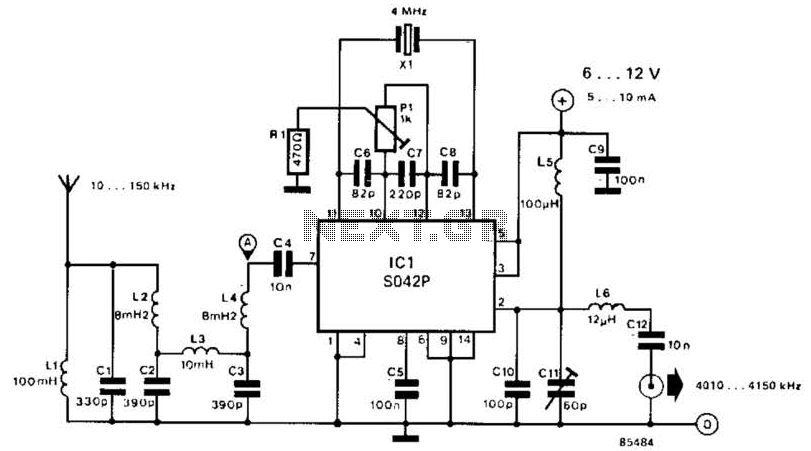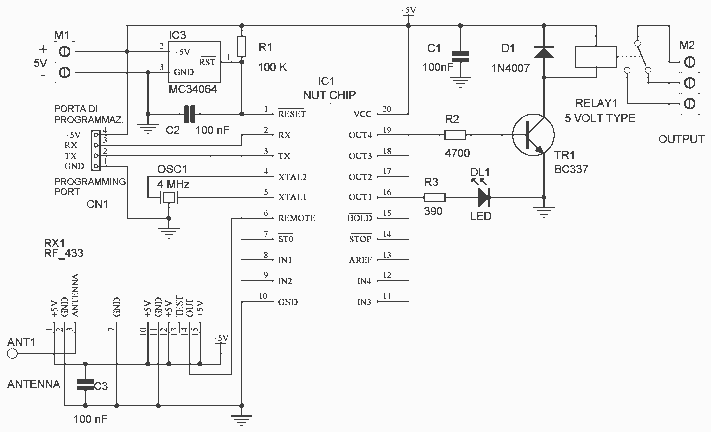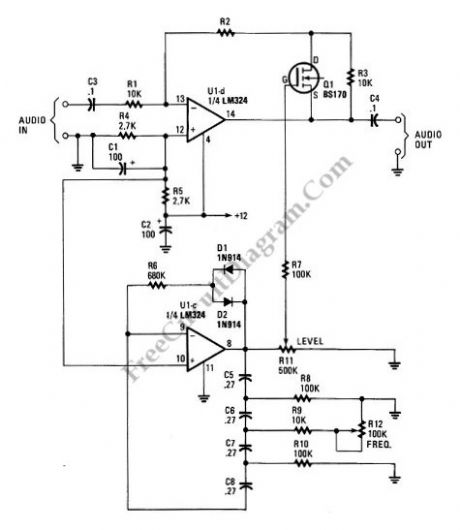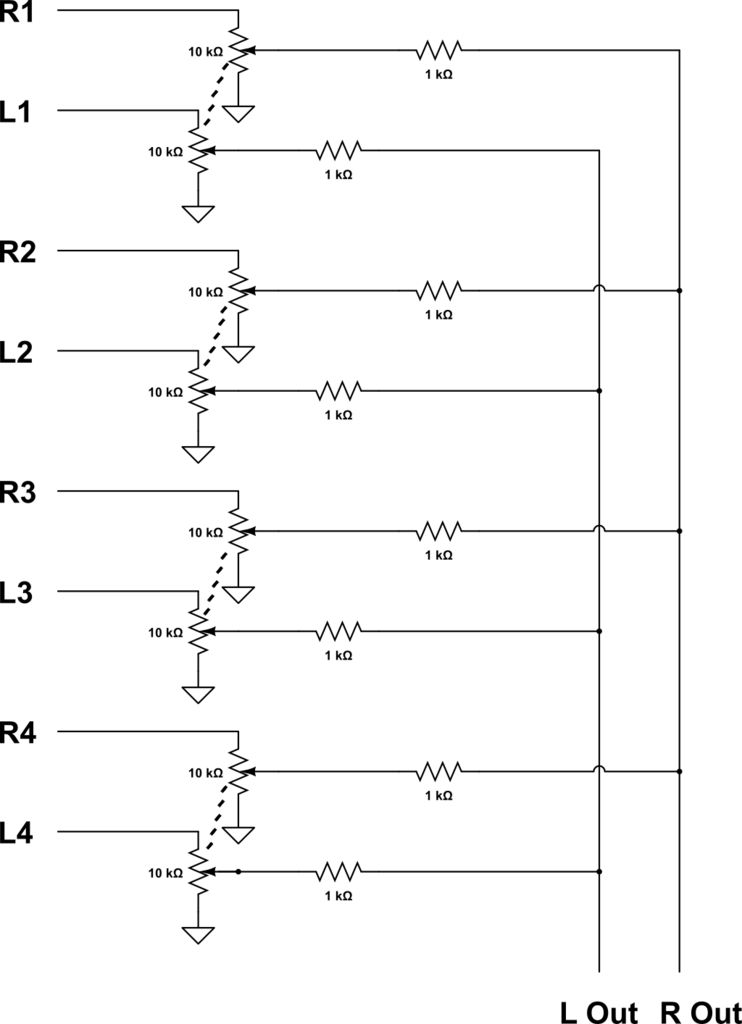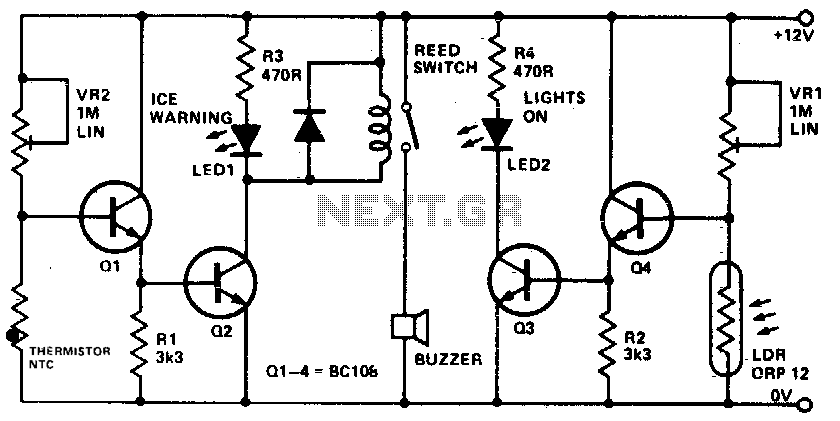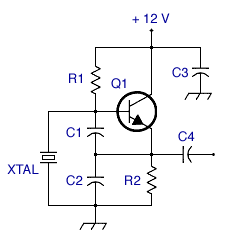
Traffic Light Control Circuit
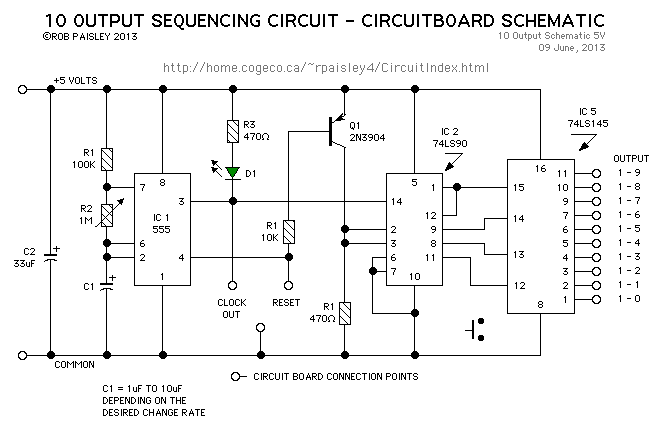
This page presents a circuit featuring twenty open collector outputs that activate sequentially in a continuous, unidirectional loop. The circuit utilizes the 74LSxx family of TTL integrated logic devices. It is designed to drive light-emitting diodes or low current, low voltage incandescent lights, but can also support other loads up to 80 milliamps. Although the 20 Step circuit is relatively straightforward, careful wiring is essential due to the characteristics of the TTL logic devices employed. Neater wiring results in better performance. Note that the 20 Step Circuit does not function in circuit simulation programs, likely due to the input states that force the outputs of the 74LS145 drivers to remain off. These states are typically not used with these devices and may not be included in the simulator's programming. For practical implementation, it is advisable to consult the first two pages of the manufacturers' datasheets for the integrated circuits. Searching for "74ls(part number)" along with "PDF" on Google can yield useful datasheets. The circuit does not directly drive the 74LS145s; instead, it employs a 74LS107 JK Flip-Flop and four 74LS32 dual input OR gates to manage the inputs to the two 74LS145 output drivers. The 74LS107 and 74LS32 are utilized to create disallowed states in the output drivers alternately, ensuring that only one of the 74LS145s can produce a LOW output state at any given time. This configuration allows the circuit to count to 10 twice in succession rather than counting to 20 in one cycle. This unique logic arrangement enables efficient use of the open collector outputs of the 74LS145s decoder/drivers, rather than relying on output buffer ICs driven by 74LS138 logic devices with eight steps. A parts list for the 20 Output Sequencing Circuit is provided, with Mouser Electronics part numbers included, though components may also be sourced from other suppliers, particularly those handling NTE components. The cost for the 20 Output Sequencing Circuit boards is $12.50 US each, plus postage, with subsequent boards priced at $12.00 each. Note that some components included in the kit may not originate from Mouser Electronics. The following diagram and image illustrate external controls for manually starting, stopping, and resetting the circuit. Upon reset, the 555 clock ceases operation, and the number 1 output transitions to a LOW state. If the RESET terminal is held LOW, the circuit will run continuously. The RUN terminal has limitations, as detailed in the device's datasheet. The photo also indicates the locations of the RUN and RESET connections on the circuit board, including a jumper that must be removed from the RUN connection to the circuit common. Additionally, 5-volt and common connections are available for powering external circuitry. If the 555 timer is removed, an external clock can be used to step the circuit, or the circuit's 555 clock can provide an output to an external circuit. When push button S1 is pressed, the output of the 555 clock will go LOW, advancing the output of the circuit by one step. Moving DPDT switch S2 to the right resets the circuit, preventing further counting. The resetting circuit utilizes an external 556 timer to generate complementary HIGH and LOW outputs connected to the RESET and RUN terminals of the circuit board. In the provided example, the reset pulse duration is approximately 0.1 seconds, but it can be adjusted using resistor R-R and capacitor C-R. The cycle can be halted at a specific output by connecting...
The 20 Output Sequencing Circuit is designed to sequentially activate its outputs, making it suitable for applications requiring a systematic approach to control multiple devices. Each output is capable of driving loads up to 80 milliamps, which allows for versatility in applications ranging from lighting to signaling mechanisms. The circuit's reliance on the 74LSxx series of TTL logic devices ensures that it operates with high-speed performance and reliability.
The architecture of the circuit is built around the 74LS107 JK Flip-Flop, which serves as the fundamental state storage element, enabling the counting mechanism. The addition of the 74LS32 dual input OR gates facilitates the creation of the necessary conditions for the counting sequence while preventing simultaneous activation of multiple outputs, which is critical for maintaining the integrity of the sequence.
In practical terms, the circuit can be reset and controlled externally, allowing for integration into larger systems or standalone operation. The ability to utilize a 555 timer or an external clock source provides flexibility in how the circuit is implemented, catering to various user requirements.
Proper attention to wiring and layout is emphasized to mitigate potential issues associated with TTL logic, such as signal integrity and noise susceptibility. The implementation of disallowed states is a key feature that enhances the circuit's functionality, ensuring that only one output is active at any time, thus preventing unintended interactions among outputs.
Overall, this circuit serves as an effective solution for applications requiring sequential control of multiple outputs, leveraging the capabilities of TTL logic devices to achieve reliable performance and ease of integration.This page features a circuit that has twenty open collector outputs that turn on one at a time in a continuous, unidirectional loop sequence. The circuit uses the 74LSxx family of TTL integrated logic devices. The circuits are designed to drive light emitting diodes or low current, low voltage incandescent lights but can also drive other loads of
up to 80 milliamps. As logic circuits go, the 20 Step circuit is fairly simple but due to the nature of the TTL Logic devices used, care must be taken when wiring these circuits. Simply put; The neater the wiring the better. NOTE:The 20 Step Circuit does not work in circuit simulation programs. The likely cause is that this circuit uses input states that force the outputs of the 74LS145 drivers to be turned off.
These states would normally not be used with these devices and are probably not programmed into the simulator`s software. If you would like to make use of these circuits, take the time to find and read at least the first 2 pages of the manufactures datasheets for the integrated circuits.
Using Google, search for "74ls(part number)" in the first box and "PDF" in the second box on the advanced search page. The circuit does not drive the 74LS145`s directly but uses a 74LS107 JK Flip-Flop and four 74LS32 dual input OR gates to control to the inputs to the two 74LS145 output drivers.
The 74LS107 and 74LS32 are used to create disallowed states in the output drivers alternately. The disallowed states prevent any of the ten outputs on that particular device from being turned ON while the other 74LS145 is in counting to ten. This produces a system where only one of the 74LS145`s is able to produce a LOW output state at a time.
In essence the circuit counts to 10 twice in succession rather than counting to 20 in a single cycle. This is an unusual logic scheme but it allows the circuit to make economical use of the open collector outputs of the 74LS145s decoder/drivers rather using output buffer ICs that are driven by 74LS138 logic devices which have eight steps.
The following is a parts list for use with the 20 Output Sequencing Circuit. Mouser Electronics part numbers are shown but the parts may be available from other sources as well. Suppliers that handle `NTE` components should be able to get the ICs. The price of the 20 Output Sequencing Circuit circuit boards is: $12. 50 US each plus postage. (Each additional board is 12. 00 dollars. ) NOTE: Some of the components supplied with the kit are not from Mouser Electronics. The next diagram and image shows external controls that can be used to manually Start, Stop and Reset the circuit. When the circuit is reset the 555 clock will stop and the number 1 output will go to a LOW state. If the RESET terminal is held LOW the circuit will run continuously. The RUN terminal has limitations (CLOCK input of the 74LS107) that are explained on the data sheet for the device.
The next photo shows the location of the RUN and RESET connections on the circuit board. A jumper normally between the RUN connection and the circuit common must be removed first. Also shown are 5 volt and common connections that can be used to power external circuitry. If the 555 timer is removed, an external clock could be used to step the circuit. Alternately the circuit`s 555 clock could provide an output to and external circuit. When push button S1 is closed the output of the 555 clock will go LOW and the output of the circuit will advance by one step. When DPDT switch S2 is moved to the right the circuit is reset and counting cannot advance. The resetting circuit uses an external 556 timer to provide complimentary HIGH and LOW outputs that are connected to the `RESET` and `RUN` terminals of the circuit board.
In the example shown the reset pulse is approximately 0. 1 seconds long but could be of any length as set by resistor R-R and capacitor C-R. The cycle can be stopped at a particular output by connecting 🔗 External reference
The 20 Output Sequencing Circuit is designed to sequentially activate its outputs, making it suitable for applications requiring a systematic approach to control multiple devices. Each output is capable of driving loads up to 80 milliamps, which allows for versatility in applications ranging from lighting to signaling mechanisms. The circuit's reliance on the 74LSxx series of TTL logic devices ensures that it operates with high-speed performance and reliability.
The architecture of the circuit is built around the 74LS107 JK Flip-Flop, which serves as the fundamental state storage element, enabling the counting mechanism. The addition of the 74LS32 dual input OR gates facilitates the creation of the necessary conditions for the counting sequence while preventing simultaneous activation of multiple outputs, which is critical for maintaining the integrity of the sequence.
In practical terms, the circuit can be reset and controlled externally, allowing for integration into larger systems or standalone operation. The ability to utilize a 555 timer or an external clock source provides flexibility in how the circuit is implemented, catering to various user requirements.
Proper attention to wiring and layout is emphasized to mitigate potential issues associated with TTL logic, such as signal integrity and noise susceptibility. The implementation of disallowed states is a key feature that enhances the circuit's functionality, ensuring that only one output is active at any time, thus preventing unintended interactions among outputs.
Overall, this circuit serves as an effective solution for applications requiring sequential control of multiple outputs, leveraging the capabilities of TTL logic devices to achieve reliable performance and ease of integration.This page features a circuit that has twenty open collector outputs that turn on one at a time in a continuous, unidirectional loop sequence. The circuit uses the 74LSxx family of TTL integrated logic devices. The circuits are designed to drive light emitting diodes or low current, low voltage incandescent lights but can also drive other loads of
up to 80 milliamps. As logic circuits go, the 20 Step circuit is fairly simple but due to the nature of the TTL Logic devices used, care must be taken when wiring these circuits. Simply put; The neater the wiring the better. NOTE:The 20 Step Circuit does not work in circuit simulation programs. The likely cause is that this circuit uses input states that force the outputs of the 74LS145 drivers to be turned off.
These states would normally not be used with these devices and are probably not programmed into the simulator`s software. If you would like to make use of these circuits, take the time to find and read at least the first 2 pages of the manufactures datasheets for the integrated circuits.
Using Google, search for "74ls(part number)" in the first box and "PDF" in the second box on the advanced search page. The circuit does not drive the 74LS145`s directly but uses a 74LS107 JK Flip-Flop and four 74LS32 dual input OR gates to control to the inputs to the two 74LS145 output drivers.
The 74LS107 and 74LS32 are used to create disallowed states in the output drivers alternately. The disallowed states prevent any of the ten outputs on that particular device from being turned ON while the other 74LS145 is in counting to ten. This produces a system where only one of the 74LS145`s is able to produce a LOW output state at a time.
In essence the circuit counts to 10 twice in succession rather than counting to 20 in a single cycle. This is an unusual logic scheme but it allows the circuit to make economical use of the open collector outputs of the 74LS145s decoder/drivers rather using output buffer ICs that are driven by 74LS138 logic devices which have eight steps.
The following is a parts list for use with the 20 Output Sequencing Circuit. Mouser Electronics part numbers are shown but the parts may be available from other sources as well. Suppliers that handle `NTE` components should be able to get the ICs. The price of the 20 Output Sequencing Circuit circuit boards is: $12. 50 US each plus postage. (Each additional board is 12. 00 dollars. ) NOTE: Some of the components supplied with the kit are not from Mouser Electronics. The next diagram and image shows external controls that can be used to manually Start, Stop and Reset the circuit. When the circuit is reset the 555 clock will stop and the number 1 output will go to a LOW state. If the RESET terminal is held LOW the circuit will run continuously. The RUN terminal has limitations (CLOCK input of the 74LS107) that are explained on the data sheet for the device.
The next photo shows the location of the RUN and RESET connections on the circuit board. A jumper normally between the RUN connection and the circuit common must be removed first. Also shown are 5 volt and common connections that can be used to power external circuitry. If the 555 timer is removed, an external clock could be used to step the circuit. Alternately the circuit`s 555 clock could provide an output to and external circuit. When push button S1 is closed the output of the 555 clock will go LOW and the output of the circuit will advance by one step. When DPDT switch S2 is moved to the right the circuit is reset and counting cannot advance. The resetting circuit uses an external 556 timer to provide complimentary HIGH and LOW outputs that are connected to the `RESET` and `RUN` terminals of the circuit board.
In the example shown the reset pulse is approximately 0. 1 seconds long but could be of any length as set by resistor R-R and capacitor C-R. The cycle can be stopped at a particular output by connecting 🔗 External reference
